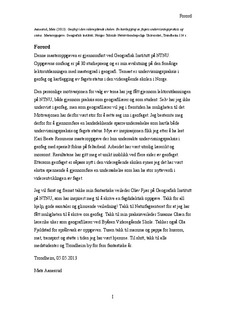| dc.description.abstract | In 2007 the subject Geosciences was introduced in the Norwegian upper secondary education. Geosciences is concerned with the basic elements of natural environments, such as bedrock, loose masses, air and water. These resources play a fundamental social and economic role both locally and globally, and are closely linked to the Norwegian economy. The curriculum in the subject focuses on fieldwork and the use of different geographical tools.
This thesis focuses on the teachers’ educational practice in the geosciences. So far little research have been done focusing purely on educational practice in the subject. However there have been written a few master theses and several articles focusing on different aspects on teaching in the subject, mostly on the use of fieldwork and geographical information systems. This thesis is also concerned with the subjects’ status within the Norwegian upper secondary education.
Two electronic surveys were conducted. One large survey conducted to all the geoscience teachers, researching their educational practice. 57 teachers from 78 schools responded, giving a response rate of 73%. One smaller survey was also distributed to 300 schools researching reasons to why schools don’t offer the subject to their students. The response rate here was 26%.
The results from the main survey shows that the most popular teaching aid is the subject’s textbooks, followed by the use of internet and visual aids such as films, animations and PowerPoint. Fieldwork and the use of digital tools are also utilized frequently among the teachers. The study shows that the geoscience teachers use a range of different teaching aids in their practice.
The teachers identify many challenges. Mentioned by most, are challenges related to fieldwork. The teachers also experience difficulties with some of the themes within the subject and the use of different digital tools. There are also concerns regarding the textbooks and the curriculum. The written exam in the geosciences 2 subject is also Abstract problematic. These results correspond with previous studies (Remmen 2008, Merkesvik 2012, Slaattun & Nilsen 2009).
One solution to the challenges regarding fieldwork and GIS could be providing the teachers with better teaching resources. Such resources can be included in the textbooks or provided online. It is important that the teachers are included when the textbooks are being revised. It will also be important to work on these challenges within the regional geoscience networks along with supplementary teaching. Two thirds of all the geoscience teachers are members of a regional network, and it should be an important goal to include more teachers.
In spite of a 5% decrease in schools offering the geoscience nationwide, the subject has a strong position within the upper secondary education. The results show that the resources spent on introducing and strengthening the subject has paid of. Most schools offer more than one of the three geosciences and most schools will offer more than one geosciences subject next year. The biggest challenge for the geosciences in the future is coping with the competition among the other subjects within the upper secondary schools. This study shows that the geography teachers and the geosciences teachers play an important role in this work. The future of the subject relies on passionate teachers who can communicate the subject’s unique content to their students. | nb_NO |
